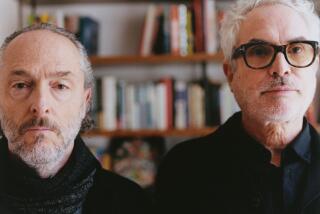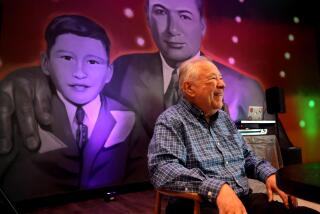Land of the straight shooters
MUCH has been made of the fraternal bond among directors Alejandro Gonzalez Inarritu, Guillermo del Toro and Alfonso Cuaron. But the Mexican “It Boys” of cinema might still be in the dark were it not for a parallel brotherhood of light.
Long before they befriended one another, the would-be directors teamed with cinematographers, partnerships that have since created images that define cinema’s “Generacion Mex.”
It’s been more than two decades since Cuaron and Emmanuel Lubezki met in film school, but in a rudimentary way the documentary short subjects they shot in college aspired to the same realism and harsh objective truths as their upcoming feature -- their fifth together -- the $75 million sci-fi thriller “Children of Men,” starring Clive Owen.
For their first short film, Cuaron and Lubezki borrowed a 16-millimeter camera from Guillermo Navarro, an autodidact cinematographer who soon thereafter met Del Toro, a special effects artist turned director. This winter’s “Pan’s Labyrinth” marks Del Toro and Navarro’s fourth collaboration and is Mexico’s Oscar submission for best foreign language film.
As for Inarritu, considering that he met Rodrigo Prieto on the sets of Mexico City’s TV shows and commercial shoots -- home base for cheesy beauty lighting -- it’s jolting that the director and the director of photography would graduate to nakedly lighted and erratically framed dramas.
But with their third film, “Babel,” an intimate $25-million globe-trotter starring Brad Pitt, Prieto further evolves the team’s cinematic style, employing varying film stocks, lenses and color saturation to depict distinct geographic story lines.
“We wanted to underline emotionally what’s happening to the characters,” Prieto says.
By lacing a subtle red color palette throughout, the director and director of photography tie four interlocking stories together because “after all, these people are on the same planet, and that’s what the movie is all about.”
Navarro crosses a similar visual bridge in “Pan’s Labyrinth,” deftly interweaving dramatically opposed ideals -- fascism and naive fantasy -- into a singular world seen through tense chiaroscuro lighting. “We were dealing with parallel universes in a period piece with complicated human relations,” he says. “The aesthetics of the drama really helped knit this complicated visual web.”
If Navarro’s camera is an empathetic span through Del Toro’s imagined landscapes, Prieto’s camera in “Babel” is a full participant, dancing shoulder to shoulder with the actors.
Although “Children of Men” is just as restlessly interactive, Lubezki’s docu-style lensing is less participatory and more observational. And like “Babel,” every take in “Children” is primarily lighted with found light and filmed with hand-held cameras.
The latter choice was a sore point -- philosophically and physically for Lubezki, since the cameras weigh about 40 pounds. When the three-time Oscar-nominated cinematographer argued to intersperse the movie’s long hand-held takes with Steadicam and conventional coverage, Cuaron refused.
“The appetite of Cuaron -- his stubbornness, his genius -- are my biggest conflict,” Lubezki says. “I cannot explain it. Even if we go a few years between films, when we pick up again, we are exploring very similar things.”
More to Read
Only good movies
Get the Indie Focus newsletter, Mark Olsen's weekly guide to the world of cinema.
You may occasionally receive promotional content from the Los Angeles Times.










